
Greta Garbo was a Swedish-American actress. Regarded as one of the greatest actresses to ever be on screen, she was known for her melancholic, somber persona, her film portrayals of tragic characters, and her subtle and understated performances. In 1999, the American Film Institute ranked Garbo fifth on its list of the greatest female stars of classic Hollywood cinema.

Anna Christie is a play in four acts by Eugene O'Neill. It made its Broadway debut at the Vanderbilt Theatre on November 2, 1921. O'Neill received the 1922 Pulitzer Prize for Drama for this work. According to historian Paul Avrich the original of Anna Christie was Christine Ell, an anarchist cook in Greenwich Village, who was the lover of Edward Mylius the English radical who libeled the British king George V.
La Dame aux Camélias is a novel by Alexandre Dumas fils. First published in 1848 and subsequently adapted by Dumas for the stage, the play premiered at the Théâtre du Vaudeville in Paris, France, on February 2, 1852. It was an instant success. Shortly thereafter, Italian composer Giuseppe Verdi set about putting the story to music in the 1853 opera La traviata, with female protagonist Marguerite Gautier renamed Violetta Valéry.

Salka Viertel was an Austrian Jewish actress and Hollywood screenwriter. While under contract with Metro-Goldwyn-Mayer from 1933 to 1937, Viertel co-wrote the scripts for many movies, particularly those starring her close friend Greta Garbo, including Queen Christina (1933) and Anna Karenina (1935). She also played opposite Garbo in MGM's German-language version of Anna Christie in 1930.
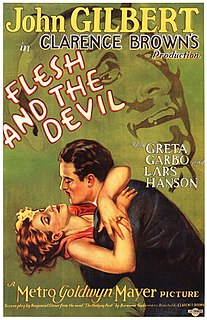
Flesh and the Devil is an American silent romantic drama film released in 1926 by Metro-Goldwyn-Mayer and stars Greta Garbo, John Gilbert, Lars Hanson, and Barbara Kent, directed by Clarence Brown, and based on the novel The Undying Past by Hermann Sudermann.
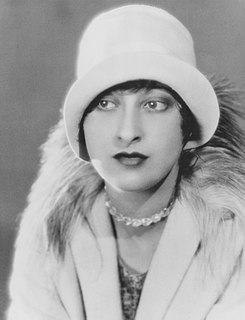
Ruth Harriet Louise was an American photographer. She was the first woman photographer active in Hollywood, and she ran Metro-Goldwyn-Mayer's portrait studio from 1925 to 1930.
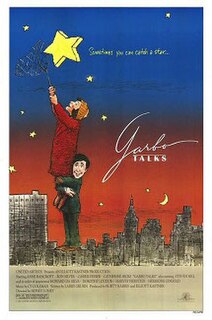
Garbo Talks is a 1984 American comedy-drama film directed by Sidney Lumet and starring Anne Bancroft, Ron Silver, and Carrie Fisher, with a cameo appearance by Betty Comden as Greta Garbo.
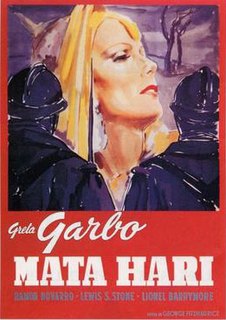
Mata Hari is a 1931 American pre-Code drama film directed by George Fitzmaurice loosely based on the life of Mata Hari, an exotic dancer and courtesan executed for espionage during World War I. The Metro-Goldwyn-Mayer film stars Greta Garbo in the title role. It was Garbo's most commercially successful vehicle. Only a censored version of the film is currently available.

Camille is a 1936 American romantic drama film from Metro-Goldwyn-Mayer directed by George Cukor, and produced by Irving Thalberg and Bernard H. Hyman, from a screenplay by James Hilton, Zoë Akins, and Frances Marion. The picture is based on the 1848 novel and 1852 play La dame aux camélias by Alexandre Dumas. The film stars Greta Garbo, Robert Taylor, Lionel Barrymore, Elizabeth Allan, Jessie Ralph, Henry Daniell, and Laura Hope Crews. It grossed $2,842,000.

Anna Karenina is a 1935 Metro-Goldwyn-Mayer film adaptation of the 1877 novel Anna Karenina by Leo Tolstoy and directed by Clarence Brown. The film stars Greta Garbo, Fredric March, Basil Rathbone, and Maureen O'Sullivan. There are several other film adaptations of the novel.

Anna Christie is a 1930 Metro-Goldwyn-Mayer pre-Code tragedy film adaptation of the 1921 play of the same name by Eugene O'Neill. It was adapted by Frances Marion, produced and directed by Clarence Brown with Paul Bern and Irving Thalberg as co-producers. The cinematography was by William H. Daniels, the art direction by Cedric Gibbons and the costume design by Adrian.
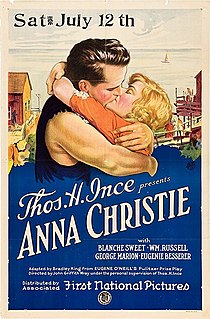
Anna Christie is a 1923 American silent drama film based on the 1921 play by Eugene O'Neill and starring Blanche Sweet and William Russell.
Anna Christie is a 1921 play by Eugene O'Neill.

Anna Sten was a Ukrainian-born American actress. She began her career in stage plays and films in the Soviet Union before traveling to Germany, where she starred in several films. Her performances were noticed by film producer Samuel Goldwyn, who brought her to the United States with the aim of creating a new screen personality to rival Greta Garbo. After a few unsuccessful films, Goldwyn released her from her contract. She continued to act occasionally until her final film appearance in 1962.

The Saga of Gösta Berling is a 1924 Swedish romantic drama film directed by Mauritz Stiller and released by AB Svensk FAB Svensk Filmindustri, starring Lars Hanson, Gerda Lundequist and Greta Garbo in her domestic film breakthrough. It is based on Swedish Nobel Prize-winning author Selma Lagerlöf's 1891 debut novel Gösta Berlings saga. The film is also known as Gösta Berling's Saga, The Story of Gösta Berling and The Atonement of Gösta Berling.
This is a list of adaptations of Anna Karenina, the 1877 novel by Leo Tolstoy.
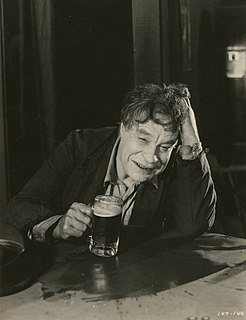
George Francis Marion Sr. was an American film and stage actor and director, known for Anna Christie, both (1923) and (1930), and Death from a Distance (1935). Marion acted in 35 films between 1915 and 1935.

Joyless Street, a film based on the novel by Hugo Bettauer and directed by Georg Wilhelm Pabst in Germany, is one of the first films of the New Objectivity movement. Greta Garbo stars in her second major role. The film is often described as a morality story in which the 'fallen woman' suffers for her sins, while the more virtuous is rewarded.
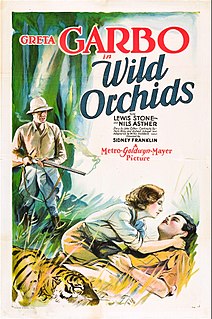
Wild Orchids is a 1929 American silent drama film from Metro-Goldwyn-Mayer directed by Sidney Franklin and starring Greta Garbo, Lewis Stone and Nils Asther. Only these three stars received cast credit. The plot is very similar to Garbo's later sound film, The Painted Veil (1934).

A multiple-language version film, often abbreviated to MLV, is a film, especially from the early talkie era, produced in several different languages for international markets. To offset the marketing restrictions of making sound films in only one language, it became common practice for American and European studios to produce foreign-language versions of their films using the same sets, crew, costumes, etc. The first foreign-language versions appeared in 1929 and largely replaced the International Sound Version method for many major releases. The most common languages used for these productions were English, Spanish, French and German.

















